Dear Friend,
The spread of COVID-19, popularly known as Coronavirus, is taking strange turns. The coronavirus crisis in China is improving while it is spreading in other countries including the U.S. The worldwide death toll, up to March 2, 2020, topped 3,000, and the number of cases tops nearly 90,000 in about 80 countries. However, world health officials sought to reassure the public that the virus remains a manageable threat.
Kindly support honest journalism to survive. https://countercurrents.org/subscription/
If you think the contents of this news letter are critical for the dignified living and survival of humanity and other species on earth, please forward it to your friends and spread the word. It's time for humanity to come together as one family! You can subscribe to our news letter here http://www.countercurrents.org/news-letter/.
In Solidarity
Binu Mathew
Editor
Countercurrents.org
China’s coronavirus crisis wanes while epidemic takes hold in U.S. and spreads
to 80 countries
by Countercurrents Collective
The spread of COVID-19, popularly known as Coronavirus, is taking strange turns. The coronavirus crisis in China is improving while it is spreading in other countries including the U.S. The worldwide death toll, up to March 2, 2020, topped 3,000, and the number of cases tops nearly 90,000 in about 80 countries. However, world health officials sought to reassure the public that the virus remains a manageable threat.
U.S. public health departments scramble against coronavirus, decimated by funding cuts
by Countercurrents Collective
The U.S. state and local public health offices are scrambling to respond to the coronavirus outbreak. They are doing so against a backdrop of years-long
budget cuts, leaving them without the trained employees or updated equipment to adequately address the virus’ growing threat, former public health officials say.
‘Do wear masks but don’t think you’re safe’: Top Soviet virologist & WHO expert explains Covid-2019 & debunks popular myths
by Countercurrents Collective
With no coronavirus vaccine in existence, quarantine has become the major tool to contain its spread. Whereas China has put entire cities on lockdown, other countries quarantined travelers who returned or were evacuated from the virus-hit region. “In case of coronavirus, it makes some sense,” Lvov commented, before taking on other protective measures, namely the mass-market medical masks. “These cheesecloth rags called ‘masks’ are not masks, they’re useless,” he stated. However, dense masks
equipped with respirators which are seen in China and Russia, are “a different thing.” Such masks “protect against [the virus], they protect the others if you’re sick” – but they are almost useless against the inbound threat.

As coronavirus fears spread, a world-renowned virologist has explained when Covid-2019 will fade away and, whether medical masks are of any use.
Around the world, public anxiety grows, with people embarking on panic buying and even fighting for medical masks.
But for initiated professionals, the Covid-2019 is just one of many epidemics that come and go without inflicting devastating losses to humankind.
Virologist Dmitry Lvov, who made his name on researching the most dangerous viruses in the former USSR and beyond, explained why this is the case during a sit-down with journalist Anton Krasovsky for RTD’s ‘Epidemic’ series.
Is Covid-2019 deadlier than other viruses?
The novel virus, which so far killed over 3,000 people, is hard to fight because it rapidly hits the lower levels of respiratory systems, causing blood and oxygen to break into the alveoli.
Consequently, “blood, blood plasma and other elements of blood cause pulmonary edema so that the human can’t breathe and dies,” Lvov said. “And it’s very hard to reach them.”
Whereas nearly 90,000 coronavirus cases were reported worldwide, “flu has infected around 5 million.” And despite its lesser mortality, influenza has killed “a lot more people” within the same period of time.
‘Quarantine makes some sense, but wearing mass-market medical masks do not’
With no coronavirus vaccine in existence, quarantine has become the major tool to contain its spread. Whereas China has put entire cities on lockdown, other countries quarantined travelers who returned or were evacuated from the virus-hit region.
“In case of coronavirus, it makes some sense,” Lvov commented, before taking on other protective measures, namely the mass-market medical masks.
“These cheesecloth rags called ‘masks’ are not masks, they’re useless,” he stated. However, dense masks equipped with respirators which are seen in China and Russia, are “a different thing.” Such masks “protect against [the virus], they protect the others if you’re sick” – but they are almost useless against the inbound threat.
Asked again if medical masks are an efficient protective measure, the scientist reiterated: “Usually not. Or to the least extent.”
The virus can easily make it into the human body through eyes, so the major feature of the sought-after mask is to ensure that “your large drops [of saliva] and your snot, excuse me, will stay with you.”
I’m not saying you shouldn’t wear masks – you should, but there’s no guarantee.
What is in store for the coronavirus outbreak?
It’s hard to foresee the outcomes of the epidemic, but “if everyone worked like the Chinese, it would end very quickly,” Lvov believes. Chinese scientists have quickly framed the virus, examined its genetic structure and published the results.
Beijing has taken “extraordinary measures” to battle the virus spread, so one should “congratulate their healthcare system and the government on the sweeping measures they’ve taken,” the Russian virologist stated, adding, “they did well.”
At this stage, he said, the Covid-2019 is dispersing slower than it was, and its outbreak is likely to end in a year, according to Lvov. The virus has not yet adapted to the human population, which is called “meeting of strangers,” and its chances of becoming a human-borne disease are “slim.”
At any rate, “it will return to bats and will pop up again in ten or twenty years, maybe in China, maybe in Russia,” he predicted.
China closes 1st coronavirus hospital, built in 10 days, after last group of recovered patients discharged
Authorities in Wuhan have closed the city’s first makeshift hospital after discharging the last batch of 34 recovered coronavirus patients, as the rate of infection in the city has dropped dramatically.
Wuhan was the site of the original outbreak of the coronavirus epidemic, and the city’s response, building a new hospital in less than two weeks to handle Covid-19 patients, was seen as a modern marvel with the total number of hospital beds in the city eventually going from 5,000 to 23,000.
The hospital’s last patients were given the all clear late Monday, according to state broadcaster CCTV, amid a sharp decline in Covid-19 cases in Hubei province.
Outside of Hubei province, there were only six new cases confirmed in mainland China over the weekend.
The hospital is one of 16 built across Hubei province to handle the epidemic, in which at least 12,000 people were treated.
The head of Wuhan’s largest temporary hospital, located in an exhibition centre with beds for 2,000 patients, confirmed plans to shutter that facility by the end of March.
“If nothing special happens, I expect the operation of our makeshift hospital, the biggest one in Wuhan, could complete its historical mission by the end of March,” said Dr. Zhang Junjian, the director of the hospital.
India’s citizenship laws resemble South Africa’s Asiatic Registration Act
by Sumanta Banerjee
It was a young Indian lawyer living there, who launched a movement against the draconian Asiatic Registration Act. Mohandas Karamchand Gandhi urged the Indian inhabitants to resist the racist law, in the name of Satyagraha.’ On May 11, 1907, he announced the campaign for non-cooperation with the colonial administration against theBlack Act’ – the term to denounce the Asiatic Registration Act – urging them not to register under that Act . Among the majority of Indian residents of Transvaal who
responded to Gandhi’s call were poor Indian hawkers, middle class professionals and men and women of all faiths, who refused to give their finger print impressions. Over 2000 Indians defied the Black Act and went to prison, including Gandhi himself.
Savarkar and the Cracks in Hindutva Legacy
by Subhash Gatade
This ‘Veer’ is a divisive figure within the RSS-BJP, tough for even the Sangh parivar to paper over.
The Dilemma Of RSS/BJP In Higher Education
by Kancha Ilaiah Shepherd
RSS/BJP is filling up teaching vacancies left behind by earlier regimes very quickly using reservation as a tool with Shakha trained ABVP/RSS/BJP graduates
“Visit My Masjid” Programme gets a warm response in Tamil Nadu
by Syed Ali Mujtaba
In wake of discretion of mosques and killing of ‘Imam’ at the recent riots in Delhi, some Muslims in ‘Vaniyambadi,’ a town about 200 km from Chennai, organized a ‘Visit My Masjid’ programme at Masjid-e-Khaderpet on Sunday March 1, 2020.
Strong Man Legacies: Burying Mubarak
by Dr Binoy Kampmark
Fittingly, Egypt’s late Hosni Mubarak was given that most traditional of rehabilitative occasions, a military funeral that served to sanitise and restore. Unremarkably, the procession was led by the current President Abdel Fattah el-Sisi, accompanied by Mubarak’s two sons, Alaa and Gamal.
The Brooklyn Yeshiva Anthem Protest And Why It Is Not Antisemitic
by Ira Glunts
On Sunday, February 23 before a
match at Yeshiva University, two brave young Muslim Brooklyn College volleyball players “took a knee” during the playing of Hatikvah, the Israeli national anthem. Omar Rezika (Soph.) and Hunnan Butt (Fr.) following the example of NFL football player, Colin Kaepernick, who protested the police brutality in the US African-American community, were protesting the brutality of the Israeli occupation and its apartheid policies toward its non-Jewish residents.
Just Another ‘Deal’? The Question of Aafia Siddiqui and Restorative Justice
by Junaid S Ahmad
Yesterday, March 2nd, was the birthday of Dr. Aafia Siddiqui. People may be forgiven (should they be?) for forgetting about Aafia since these seventeen birthdays of hers have gone by with her incarcerated, humiliated, tortured, and God knows what in one American gulag to another. But these seem to be ‘minor’ details
right now.
Patterns of Occupied Palestine and Kashmir: Part 4 of Uncountable
by Priti Gulati Cox
https://countercurrents.org/2020/03/patterns-of-occupied-palestine-and-kashmir-part-4-of-uncountable
Priti Gulati Cox brings to life martyrs of Palestine and Kashmir
Aaj Woh Kashmir Hai Mehkoom-O-Faqeer
Kal Jise Ahl-E-Nazar Kehte Thay Iran-E-Sagheer
(Today that land of Kashmir, under the heels of the enemy, has become weak, helpless and poor
Once known among the wise as Little Iran)
— Allama Muhammad Iqbal, poet and philosopher of Kashmiri origin, “The Poet who Introduced Language of Resistance in Kashmir,” New Frame, July 11, 2019
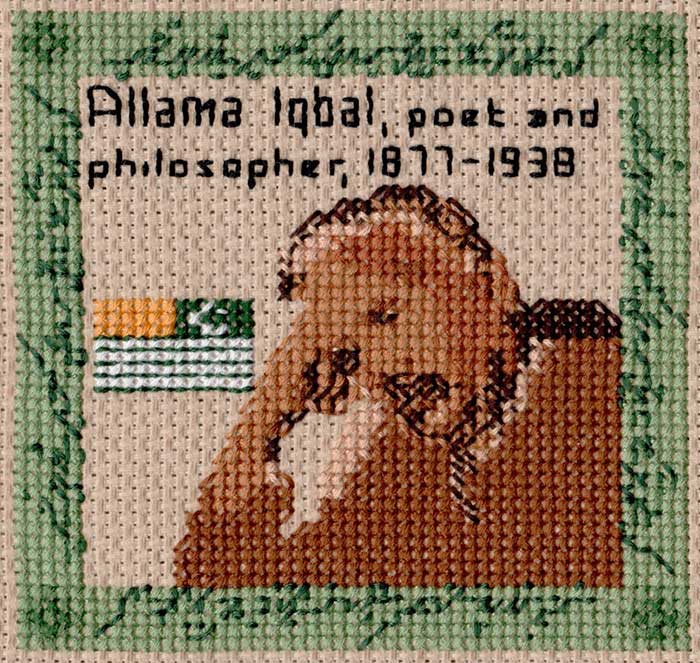
On June 14, 2018 two people representing similar struggles in two different parts of the world were murdered. One of them, 21-year-old Ahmad Ziad Tawfiq al-‘Aassi lived in occupied Palestine, and the other, 50-year-old Shujaat Bukhari lived in occupied Kashmir.
For almost half a century, Kashmir has been ruled from Delhi with the utmost brutality… Prime Ministers Benjamin Netanyahu and Narendra Modi… are now passionate bedfellows, and Israeli “advisers” have been seen again in recent years in Kashmir renewing the close intelligence and security cooperation that dates from the early 2000s. The revocation of Article 370, which protected Kashmir’s demography by restricting residency to Kashmiris alone and, under a sub-section known as Article 35A, forbade the sale of property to non-Kashmiris, and the planned division of Kashmir into three separate Bantustan statelets, bear hallmarks of the Israeli occupation in Palestine.
—Tariq Ali, “Kashmir on the Edge of the Abyss,” NYR Daily,August 10, 2019
When it comes to heinous atrocities committed daily by Israel on the Palestinians, and by India on the people of Kashmir, there is zero accountability. The vicious cycle of impunity enjoyed by these two occupying powers has deep roots in their respective exceptionalist ideologies: Zionism and Hindutva. As pointed out by the online news organization MEE, “Modi and Netanyahu quickly bonded in 2014 over their zealous objective to consolidate total and absolute power over their territories. They also recognized in each other the similarity of their ambitions to build supremacist democratic states with a single culture, a single race and a single nation.”
Cross-pollinate Zionism and Hindutva and you get Zionutva — a hybrid fantasy.
The ultimate goal for Zionism is to slowly but surely establish a Greater Israel; for Hindutva it is to slowly but surely establish a Hindu Rashtra, or a Hindu nation-state. In the process, Zionutva will make second-class citizens of both the Palestinians in historic Palestine and the Muslims and other minorities in India and Kashmir.
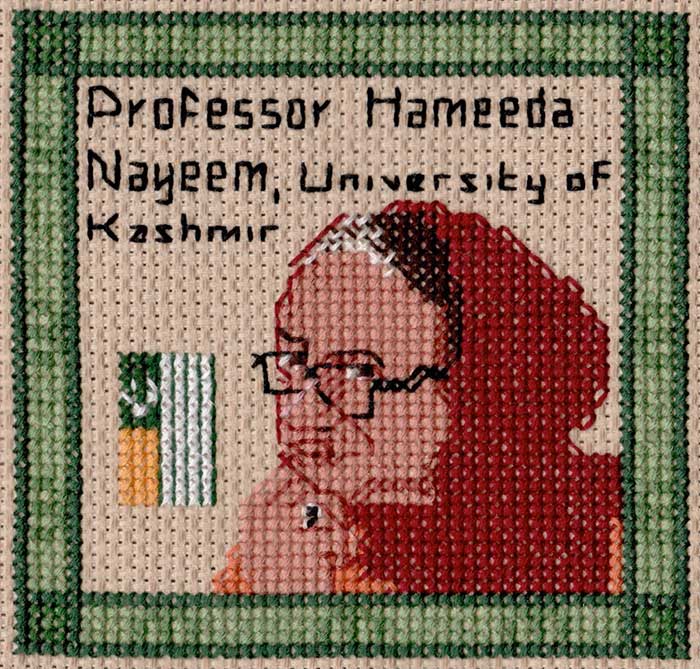
This is all bullshit… They [Hindutva] are actually hiding a dark Hindu fantasy of destroying Kashmiri Muslims and reducing them to a minuscule minority so that they can always rule them and they will be enslaved. Overnight their identity, their dignity, their everything has been lost. Kashmir has a 5000 years history as a country, all that goes down the drain…
— Prof. Hameeda Nayeem, “The Protests in Kashmir That India Didn’t Want You to See,” VICE News, August 16, 2019
Zionutva’s a fantasy, because as Prof. Nayeem describes, there can never finally be a Hindu Rashtra, or for that matter a Greater Israel on this dying planet. Before that can happen, the doomsday clock will strike midnight. Israel and India, along with bipartisan support from the United States of America — all of whom have nuclear weapons — have made it clear that they will use their ill-gotten freedom and democracy to deny the occupied Palestinians and Kashmiris their freedom and rights to self-determination. And the people of Palestine and Kashmir for their part have made it even more clear that they will stop short of nothing but getting their Azadi (Freedom) from the occupying fantasies of Zionutva. Their resistance to occupation will continue till the end of everything, or Azadi, whichever comes first.
So who are these faces and places of resistance? These stone-throwers and their brothers and sisters; these children lined up in white shrouds; these women and their sons; these obliterated families; these olive orchards with occupier-felled trees; these warehouses full of rotting apples that never made it to the market because of Kashmir’s communication lockdown; these chests wearing PRESS vests who never made it home?
Or what about these pairs of Palestinians and Kashmiris who were killed by Zionutva forces on the same day, like journalist Shujaat Bukhari and protester Ahmad Ziad; these barricaded farmlands; these artisans of vanishing crafts; these martyred “militants”; these unmarked gravesites; these endangered creatures; these stolen streams, mountains, villages and neighborhoods; these prescient professors like Hameeda Nayeem; these old and young enveloped in a debris of memories; these everything that has been occupied? Slowly but surely.


I have a very profound belief that it is difficult to have peace in the Middle East without minimal accountability certainly for the largest crimes.
— Shibli Mallat, a human rights lawyer, Sharon’s Dark Past
Estimates suggest that between 750 and 3,500 Palestinians were killed in the Sabra and Shatila massacre between September 16 and 18, following the Israeli invasion of Lebanon in 1982. The massacre was carried out by Phalange, a right-wing Maronite Christian militia with full support and coordination of the Israelis.
According to Shibli Mallat “hundreds of Palestinians were rounded up [and taken to the stadium in Beirut] under the supervision and control and with interrogation of the Israeli forces.” A cameramen who was there filmed the scene and said that the interrogations took place after the massacre.
According to Mahmoud Younis, a dental technician in Shatila, “the militia took us to the sports stadium and put us under the stairs. There were many women and children. Behind the sandbank Israeli soldiers were standing with Lebanese forces. They were together.” Mahmoud was only 12 when the massacre happened and lost his father, uncle, three brothers and three cousins.

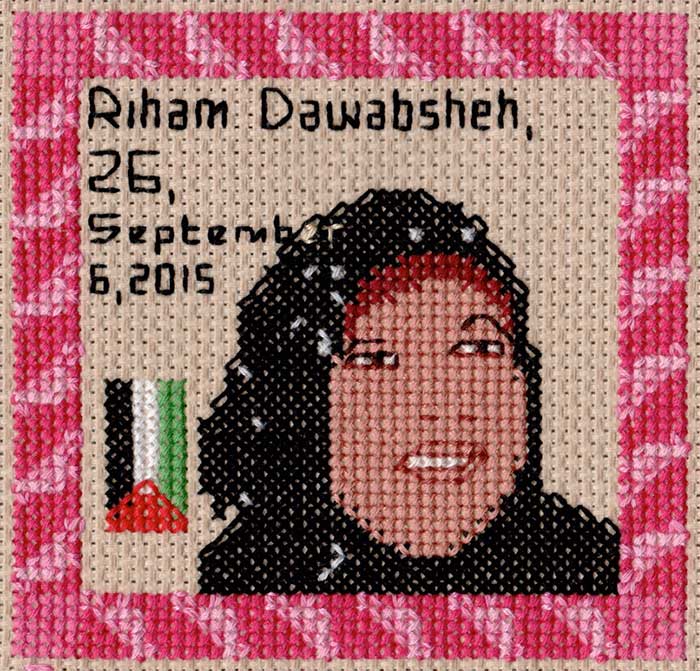
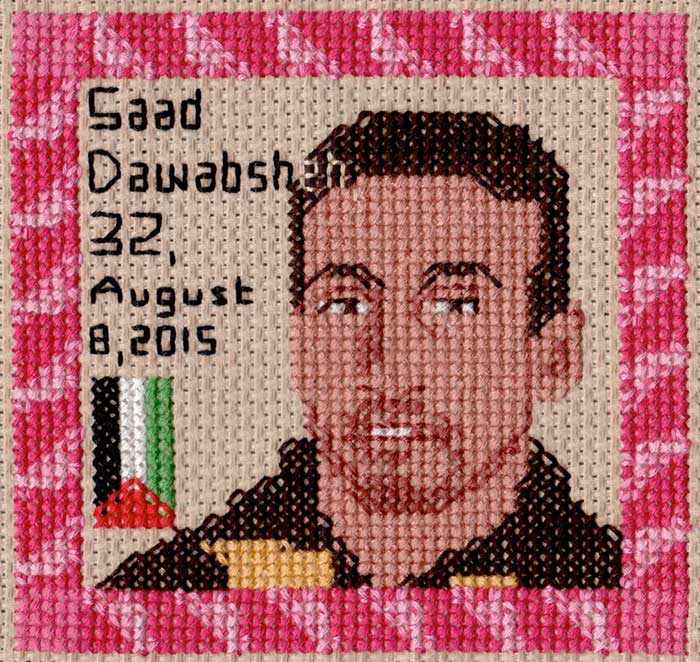
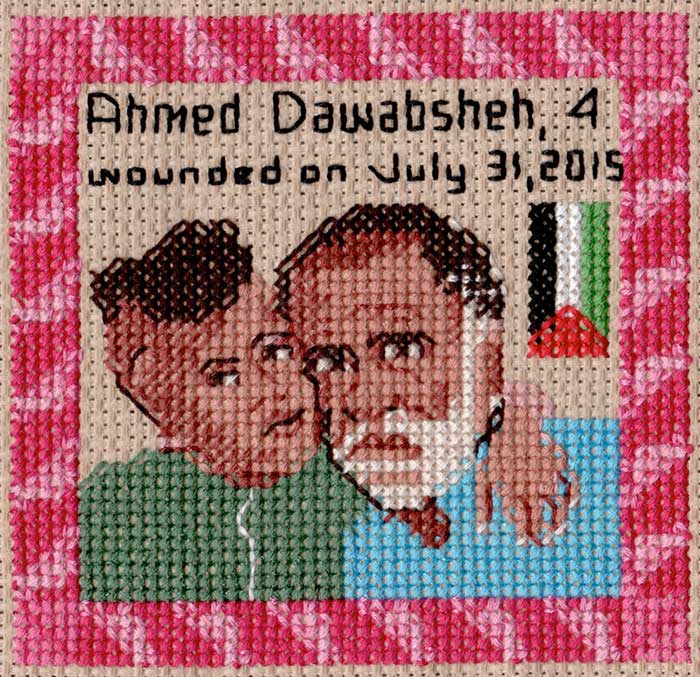
18-month-old Ali, along with his mother Reham and farther Saad were killed in an arson attack carried out by Israeli settlers in the Palestinian village of Duma in the Occupied West Bank on July 31, 2015. Ali was burnt alive in the incident, while Reham and Saad succumbed to their injuries in the coming weeks. Ali’s brother Ahmad, now 9, suffered burns on 60 percent of his body and survived the attack.
In a 2017 interview with Al Jazeera, Hussein Dawabsheh, Ahmad’s grandfather said that “when Ahmad goes to take a shower he looks at his body and asks why is my body like that? What shall I do? Why did they do that to me?”
“They,” the Israeli settlers, did this to Ahmad’s body because they can. They, along with Israeli Occupation Forces want to make an example of him, and Ali, and Reham and Saad, and other Palestinian families like them. Otherwise why would they make statements like this today and get away with it: “We will burn you as we did with Dawabsheh’s family?” After all, reportsopenDemocracy “Less than 9% of the settlers’attacks committed against Palestinians as well as their properties are punished.”
Whether you’re a journalist or a protester or a farmer or an exporter of farm produce in occupied Palestine and Kashmir, Zionutva strikes you indiscriminately and with uninterrupted impunity. Take for instance these portraits of Shujaat Bukhari and Abdul Hameed Khan in Kashmir and Ahmad Ziad Tawfiq al-‘Aassi and Yusef a-Shawamreh in Palestine:
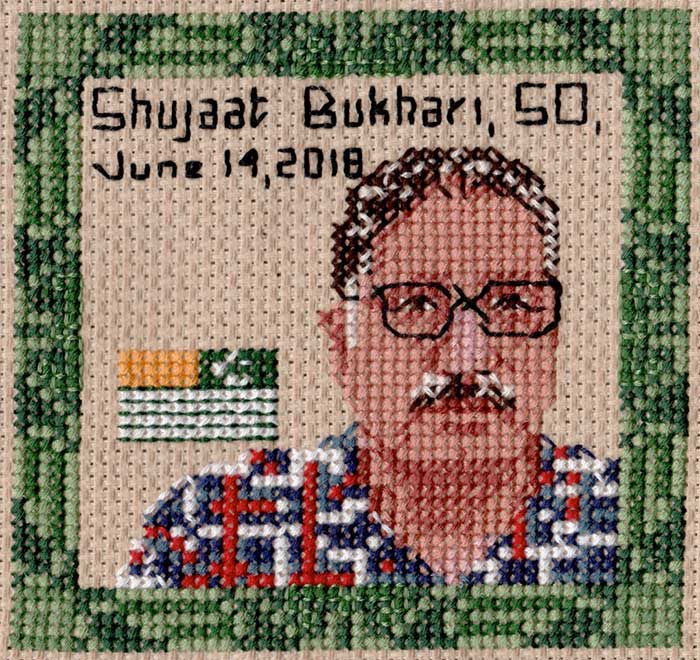
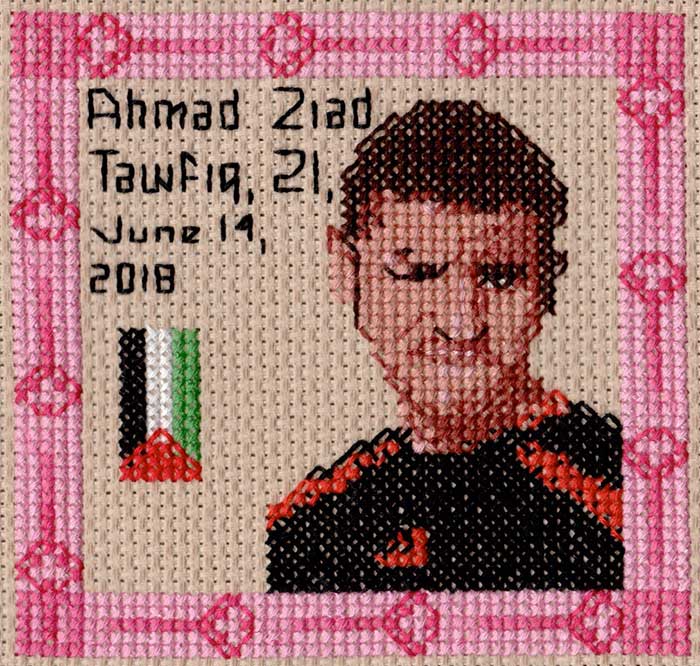
In a July 2016BBC News article titled “My Kashmir Newspaper Has Been Shut Down, And I’m Not Surprised,” Shujaat Bukhari, a senior journalist and editor of the English paper daily Rising Kashmir, wrote that “for us these restrictions [imposed by an information blockade] are not new. Since the outbreak of armed rebellion in Kashmir in early 1990, media in the region has had to work on a razor’s edge in what is effectively the world’s most heavily militarized zone… Threats to life, intimidation, assault, arrest and censorship have been part of the life of a typical local journalist.” Two years after Bukhari wrote that article, on the night before Eid-ul-Fitr, he would become one of 19 journalists murdered in Kashmir since 1990.
On that same day, on June 14, 2018, in occupied Palestine, Ahmad Ziad Tawfiq al-‘Aassi would die of serious wounds to the head that he had suffered days earlier in Khan Younis in southern Gaza. His death would bring the number of Palestinians killed by occupation forces in the context of the Great March of Return protests to 126, including 2 journalists.

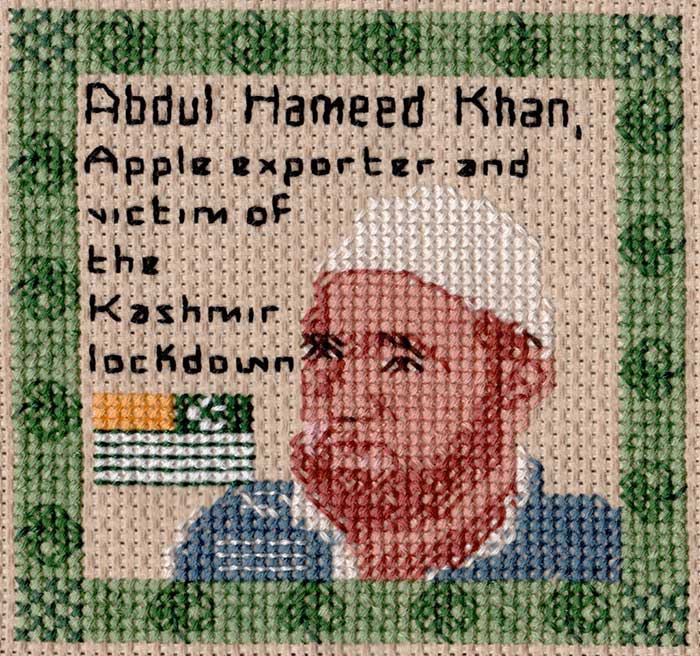
14-year-old Palestinian Yusef a-Shawamreh was shot and killed by Israeli soldiers on March 19, 2014, as he crossed the Separation Barrier to pick Gundelia from his family’s farmland that lies on the other side of the fence. According toB’Tselem, the Israeli Information Center for Human Rights in the Occupied Territories, Gundelia is “a thistle-like edible plant annually harvested at this time of year that serves as an important source of income” for the residents of the village of Deir al-‘Asal al-Foqa in the occupied West Bank where Yusef was from. “Shawamreh was shot when he and two friends… were going through a wide breach in the Separation Barrier.” There has been no justice for the killing of Yusef.
And Abdul Hameed Khan, a victim of India’s recent assault on Kashmir’s autonomy, tells us that “each year I export about 200,000 boxes of apples in the domestic markets across India. This year, because of the situation, farmers aren’t able to send their produce to market. They don’t know where to send it because communications lines aren’t working.”

Today is the second anniversary of the Intifada — the popular uprising of the Palestinian people. In the past two years over 800 people have been killed, and tens of thousands have been arrested. Because media coverage of the Intifada is incomplete and inconsistent it is difficult to know exactly what the situation really is in Occupied Palestine… Israel is the largest recipient of U.S. foreign aid and the tear gas the Israeli military uses is made in the United States.
— The Michigan Daily, December 8, 1989
15-year-old Ashraf Eid was one of those hundreds killed in the first Palestinian Intifada. There is no record of the day he died.
These faces look out at us from within the debris of these hollowed-out democracies and the uncountable memories of occupation.
Priti Gulati Cox (@PritiGCox) is an interdisciplinary artist and lives in Salina, Kansas. Her part-time studio Sidewalk Museum of Congress (SMoC) is situated outside Kanas’ 1st District Rep. @RogerMarshallMD office. Please go here to see her work.
The fancy ideas of Trump and Modi On Architecture
by Vidyadhar Date
In one respect Donald Trump seems less autocratic than Narendra Modi. Just as Modi and his administration have sought to completely redesign the area around Parliament in Delhi, Donald Trump wants to “make federal buildings beautiful again” by mandating a return to “the classical architectural style”, according to a draft executive order. But there is one essential difference.
New Westminster City Councillor to bring a motion against CAA
by Press Release
Following in the footsteps of Seattle City council, which unanimously passed a motion against the discriminatory citizenship law adopted by India, a councillor in New Westminster is going to make a similar move next week.
India’s “Pilot Project” towards Cashless Economy: Disenfranchisement through Digitization!
by P J James
The Notification issued by the Reserve Bank of India (RBI) on October 7, 2019, as per Modi government’s directive with a view to “Deepening Digital Payments” across the country is of far-reaching consequences. The Notification contains the essential guidelines fora “pilot project” to convert one selected district in every state of India into fully digital or “cashless” in all financial payments and transactions by the end
of 2020.Obviously, this pilot project is envisaged as a prelude to the eventual transformation of India as a full-fledged cashless society in the near future.
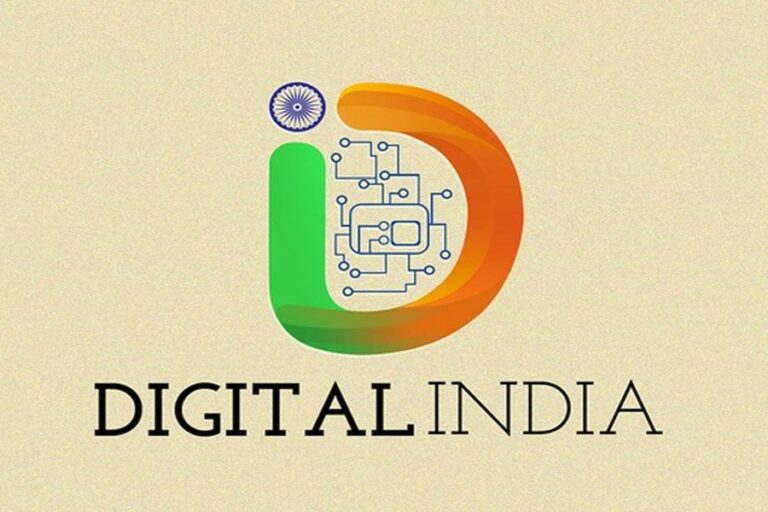
Introduction
The Notification issued by the Reserve Bank of India (RBI) on October 7, 2019, as per Modi government’s directive with a view to “Deepening Digital Payments” across the country is of far-reaching consequences. The Notification contains the essential guidelines fora “pilot project” to convert one selected district in every state of India into fully digital or “cashless” in all financial payments and transactions by the end of 2020.Obviously, this pilot project is envisaged as a prelude to the eventual transformation of India as a full-fledged cashless society in the near future. Accordingly, the task for achieving this time-bound task is entrusted with the concerned ‘Lead Bank’ of the respective district in coordination with the administrative head, the District Collector. Instructions from RBI have already gone to the State/UT Level Bankers Committees(SLBCs/UTLBCs) “to identify one district in their respective State/UTs for digital payment ecosystem on a pilot basis in consultation with banks and stakeholders” and the district identified “shall have significant footprint which will attempt to make that district 100 percent digitally enabled within one year.” The RBI Notification has also directed SLBCs/UTLBCs to ensure that such “cashless’” districts identified are converged with the “Aspirational Districts”already identified by NITI Aayog for “good governance” as part of Modi’s “Digital India” Program.
Of course, this strategic decision is not an overnight development. Its roots lay deep in the Demonetization superimposed on India by Modi at the behest of neoliberal-corporate centres. A Committee headed by Nandan Nilekani who spearheaded the Aadhar, world’s biggest biometric exercise (which, contrary to its declared objectives, has no empirical evidence on improving welfare delivery) has been working on this issue since Demonetization. Accordingly, the “High Level Committee on Deepening Digital Payments” led by Nilekani submitted its Report to the RBI in May 2019. In fact, the RBI’s Notification issued on October 7 2019 in essence is a repetition of what elucidated in the Nilekani Report. As pointed out in the Notification, the pilot project that is envisioned on an experimental basis aims at multiplying India’s ‘per capita digital transactions’ by ten times within a year–estimated at 22 as of now to 220– and increase the number of “cashless” or “digital citizens” from the current 10 crore to 30 crore by the end of 2020!
A glance at both the Nilekani Report and RBI Notification unravels the process or the various steps required for accomplishing this “pilot project” for cashless transactions within the proposed time-frame. Among other things, they comprise a concerted campaign for opening zero-balance accounts for all who are outside the banking system, an increase in the number of smart phones, swiping machines (PoS machines or terminals), linking of bank accounts with Aadhar, popularization of BHIM Aadhar Pay, discouraging cash withdrawals from banks, developing ‘feature phones’ appropriate to cashless payments, and so on. The RBI Notification does not ascribe much importance to ATMs in the transformation process towards digitization or cashless transactions. The idea is to reduce the number of ATMs which are conventionally used for cash withdrawals and to transform them mainly as CDMs (Cash Deposit Machines) so as to suck out the cash in circulation. In a cashless society, the new role of ATMS would be that of ‘digital facilitation points’ which implies a recalibration of them for bill payments, currency transactions, tax payments, mobile recharging, ticket booking, etc. A proposal is also there for the creation of specific ‘digital wallets’ for all payments and receipts pertaining to government transactions. Together with the existing US-based ‘digital tools’ such as Master Card, VISA, Debit and Credit Cards, PayPal, Apple Pay, Google Pay, Paytm (controlled by Chinese giant Alibaba) which are widely used in India, emerging tools like Phonepe (controlled by Walmart, world’s biggest MNC) and initiatives toinvolve Whats App and Facebook are also in full swing.
Background for Modi Regime’s Cashless Move
The invention of money certainly led to an epoch-making transformation in human history like that of fire and wheel. It enabled human society to transform itself from the ‘primitive’ barter system (exchange of goods for goods) to a higher stage of development where money became a medium of exchange, store of value and standard of deferred payments. And till the end of the 20th century, in political-economic circles, there had been no talk ofa cashless society or replacing cash by digital payments. In fact, discussion on cashless transactions has its beginning only in the turn of the 21st century along with the origin and development of cross-border/transnational digital flows. Over a span of two decades, broadband connections have become more important than shipping lanes and, in terms of its economic significance, are now at par with the centuries-old trade in goods. While internet penetration in US is estimated at 80 percent of the population, the same is around two-third in EU and one-third in Asia whereas in India it is only one-fourth. On the other hand, the so called “digital divide” (people having no access to internet) has become a clear manifestation of mounting economic inequality not only between imperialist and oppressed countries but also among people and groups within countries. Today digital flows have become indispensable for the movement of goods, services and above all finance, and every cross-border transaction today has a digital component. Digital business which is already in trillions is still growing in double digits. At the same time, compared with the sphere of production, it has been in the sphere of circulation and finance that digital flows have become truly a catalyst.
It is in this context that digital technology and data flows are becoming the driving force for cashless transactions. And, quite logically, the motive for this cashless initiative everywhere comes from the US- centred global corporate giants who are the custodians (with the exception of China today) of digital tools essential for cashless payments. However, ironically, among the countries which are much advanced in the realm of digital technology, only the Scandinavian countries are apparently moving towards a cashless economy. On the other hand, vast majority of the people in US which is much ahead of others in digital and network infrastructure, leading countries of EU and Japan are deadly against a cashless situation despite concerted efforts on the part of software giants, corporate financiers and monopoly banks in these countries which regularly propping up their respective governments for adopting digital payments.
For instance, with the backing of US Federal administration, various US-based software and digital giants as well as big banks are engaged in a massive and aggressive campaign for adoption of digital payments system. However such a move is vehemently opposed by various state governments in US. This has prompted the digital MNCs to target the so called ‘emerging economies’ in Afro-Asian-Latin American countries by influencing amenable regimes there. As a manifestation, various companies including VISA, Master Card, Citibank, Gates Foundation, Dell Foundation, etc. joining with the USAID (United States Agency for International Development) have already formed the “Better Than CashAlliance” initiative for seriously taking up the cashless agenda amidst stiff domestic opposition to such a move in the US. The aim of this Alliance was to manipulate policy decisions in backward economies thereby superimpose cashless payments on global people.
The ascendance of Modi regime in 2014 and the Prime Minister’s proclamation on “Digital India” program in the following year should be seen in this context. And, as an appendage of the Better Than Cash Alliance, an initiative entitled “Catalyst” with the involvement of Indian Ministry of Finance started work in since 2016. Catalyst began its operations based on the guidelines codified by USAID under what is called “Beyond Cash”. Alok Gupta, Director of Washington-based World Resources Institute, who cooperated with NandanNilekani in designing Aadhar was appointed as Indian Chief Operating Officer of Catalyst. According to available evidence, US think-tanks including neoliberal-far right economists like Larry Summers and Reghuram Rajan were associated with this project in its beginning stage. In fact, the launching of Unified Payment Interface (UPI) as the brainchild of Rajan is considered as the forerunner of cashless initiative in India. As RBI governor, it was he who imposed restrictions on cash withdrawals from ATMs, even as 37 crore new bank accounts were opened in India under Pradhan Mantri Jan DhanYojana during 2014-18 preparing the background for the move towards cashless payments. No doubt, corporate-saffron forces effectively used these Jan Dhan accounts as a convenient tool for whitening huge volumes of unaccounted black money during the opaque days of Demonetization which was a “guinea-pig” experiment superimposed on the Indian people with intellectual inputs from the USAID-led Catalyst-an aspect to be taken up in the ensuing discussion.
Meanwhile, Catalyst had attempted at launching “cashless townships” in six Indian cities- Indore, Visakhapatnam, Kota, Jaipur, Bhopal and Nagpur- on an experimental basis as part of its action plan towards a making India perfectly cashless or digital. These six cities had been selected based certain criteria such as the use and popularity of smart phones, number of digital money transfers, the availability and familiarity with digital tools among vendors and merchants at the local level, various administrative factors essential for such an experimentation and so on. As noted above, and as well-documented by international sources (see Select References attached), it was in this overall background that at the behest of neoliberal-corporate think-tanks,Modi imposed Demonetization in November 2016 that enabled the most corrupt corporate big businesses and crony capitalists hand in glove with the ruling party to have the biggest-ever one-shot wealth accumulation in history by abruptly sucking out the life-blood of more than a billion people and at the same whitening all corporate-black money hoardings through banks.
Totally paralyzing all cash-based economic activities especially in the informal/unorganized sectors that provide sustenance and livelihood to more than 90 percent of the Indian workforce, Demonetization led to an unprecedented squeeze of the entire economy resulting in the biggest unemployment and economic slowdown in five decades coupled with a galloping of all kinds of money-spinning businesses and ballooning speculation at the macro level, thereby transforming India as the most corrupt country in Asia within a year. Of course, while Modi himself was immersed in the post-truth campaign of interpreting Demonetization as “surgical strike” against terror funding, black money and counterfeiting and tried to whip up Islamophobic and Hindutva chauvinist sentiments in the process, in those crucial days, it was left to Gurumurthy, the leading RSS intellectual and member of RBI Director Board to reiterate at the behest of imperialist centres that the true aim of Demonetization was to achieve a state of cashless or digital payments. No doubt, the latest RBI Notification regarding pilot project on “digital districts” is a logical corollary and continuation of both Demonetization and Catalyst-sponsored “cashless townships” already experimented in the country. Revealingly, as the RBI itself acknowledges, a copy of this RBI Notification was forwarded to USAID-led Catalyst too.
General Consequences of Cashless Economy
The immediate outcome of a cashless economy would be total alienation or marginalization of those who (a) have no bank accounts, (b) having no cash in their accounts, (c) having no access to the appropriate ‘digital payment tools’, and/or (d) not having the technical know how required for operating them. In spite of the enrolment of millions of “zero-balance accounts” initiated on a war-time footing under Jan Dhan Yojana after Modi’s coming to power, only 60 percent of the 135 crore of Indian population has even namesake bank accounts (many of them are reported to be bogus or benami accounts too).In the event of India moving to a full-fledged cashless or digital payments system, the custodians of the entire cash or currency in the country will be big banks or such other financial entities. This will automatically “disenfranchise” those who have no valid bank accounts or those unable to operate such accounts through proper digital tools. That is, when the Modi regime under the guise of “financial inclusion” is engaged in “digitizing citizens” it needs to be understood in effect as an ingenious corporate-fascist agenda of denying citizenship itself to the marginalized and oppressed. Therefore, at a time when 30 crore Indians (almost equal to the total population of USA) are below the official poverty line and around 50 crore of people having no bank accounts still being outside the banking net, this superimposed cashless project, contrary to the claims of its proponents, is leading to “financial exclusion” and not “financial inclusion”.
Let us see the whole issue of cashless payments from an international perspective too. That the US has already reached saturation regarding the availability of smart phones with iPhone and Android facilities and credit/debit cards is a widely conceived fact today. Moreover, as already noted, the US today still continues(in spite of cut-throat competition from the Chinese digital giant Huawei) to be the biggest source of the digital/software tools such as VISA, Master Card, Apple Pay, Google Pay, Venmo, Square Cash, which have become indispensable for maintaining “digital imperialism”. Again, Walmart, the US-based biggest MNC, for instance, has its majority holding in the software tool such as Phonepe (as is the case with the Chinese giant Alibaba’s involvement in Paytm).As a result, in the World Digital Competitiveness Ranking, the US holds the top-most position today, and that of Sweden, which is moving towards cashless economy has third ranking in this regard, whereas India’s ranking is 44th among 60 countries. Thus, with all the necessary requirements, US is most favourably situated for embracing total digital payments. A study conducted by the Tuft University and published in May 2016 Issue of Harvard Business Review had unequivocally identified US, Japan, Germany, France, Belgium, Spain, Czech Republic, Brazil and China in that order as ideally placed on account of their technological capabilities and social realities to move towards a cashless situation. No doubt, as already mentioned, the formation of corporate-sponsored “Better than Cash Alliance” with its slogan “war against cash” took place in the US precisely in this context.
However, public opinion in the US from the very beginning has been vehemently against this pro-corporate cashless initiative. Upholding people’s sentiments, ten US states– Massachusetts, Connecticut, New Jersey, New York State, Washington State, Oregon, Rhode Island, Chicago, Philadelphia and California (whose GDP of $ 2.7 trillion with a population of 4 crore is equal to that of India with a population of 135 crore)—under the label “States for Cash” have enacted stringent laws with punitive measures against traders insisting on cashless payments. For example, in New Jersey, for the first violation of the law (i.e., forcing digital transfers), the fine is $ 2500 and for second violation the fine will be doubled to $5,000 (around Rs. 3.5 lac). Other states like California also have passed similar laws with criminal procedures and varying degrees of punishment. According to a New York City Council study, 11 percent of the New York residents does not have bank accounts at all. According to it, the superimposition of a cashless system of payments on the poor, immigrants and elderly who have no bank accounts is outright “disenfranchisement”, especially when the US Constitution does not insist bank account as a criterion for citizenship. In spite of having the highest potential for transforming in to cashless economy, most of the people in US prefer cash payments and more than 55 percent of transactions in the US are still under denominations of $ 10. In fact, this is the context that prompted the well-known online portal USA Today to declare “Cash is still King in USA”. The annual per capita digital transactions in the US is 474 compared with just 22 in India where the Modi regime totally cut off from concrete realities is shamelessly pursuing the cashless dream!
Specific Issues Concerning India’s Cyber Security
Issues connected with cyber security are of particular relevance when it comes to the case of India. According to cyber experts, digital flows/transfers with barely two decades of history are still like an unchartered territory. A recent BBC Report (bbc.com/worklife-101), has also pointed out the risks involved in the “payment over the cloud”and highlighted the need for proper studies on this emerging field. Serious attention is required regarding the issue of privacy. Of all digital dealings, financial transactions are subjected to highest level of surveillance and information manipulation not only by governments but also by private operators. While the rich and the powerful can ensure their privacy through extra payments, political activists and common people are always vulnerable and at the receiving end.
Cybercrimes and hacking connected with financial transactions are notorious. In this realm, India’s position is the worst. A 2015 Interpol Report situates India as having the lowest cyber security in the world. In that year, the Interpol noted around 111000 “violations” or “transgressions” in Indian cyber space. Assocham has endorsed these findings in a recent study and warned about more worries for India’s digital transactions in the near future. According to Chipset manufacturer Qualcomm, India’s hardware security is not at all compatible with digitization.It also points out how hackers can easily steal users’passwords from existing Android models. On November 15, 2019, the BBC News has released the revealing news of RBI seeking the help of “Group-IB”a Singapore-based cyber security agency to investigate the “status” of over 13 lakh Indian debit cards whose data base might have been stolen.Ironically, this RBI decision to investigate into India’s digital payments came in October 2019 when its Notification on cashless project was also released.
Still more shocking is a recent revelation made by “Group-IB” itself (The Hindu, February 8, 2020, Kochi Edition, p. 12)regarding the display of 461976 Indian card information for sale in a notorious “dark net” called “Joker’s Stash”! This hacking was possible solely because of the fragile nature of India’s cyberspace. The information leaked includes card numbers, their expiry dates, CVV / CVC codes, cardholder names, emails, phone numbers and addresses. As estimated by “Group-IB”, these data basestolen probably from PoS terminals is worth over Rs 30 crore in the cyber market. Yet another case is regarding the recent leakage through social media of passwords and e-mail ID of around 30000 customers from Flipkart’s e-wallet. Personal details hacked thus were later put on the website ‘Throbin’. Another instance pertains to a recent hacking of e-mail accounts of almost 3000 government officials at ISRO, IGCAR (Indira Gandhi Center for Atomic Research), BARC and SEBI. According to analysts, these are only tip of the iceberg. Cyber violations in India where majority of victims are common people are less reported. For instance, millions and millions of informal and unorganized workers who migrate across different states within India and who are forced to use debit cards are often victims of cyber-security breaches. According to a BBC Report, it is the first-time users of net transfer in India who are facing major financial frauds. Amidst such reports which have become frequent, the obscurantist saffron regime’s rhetoric on digitization without even having minimum cyber security arrangement has already exposed it before all the well-meaning people the world over.
The Sorry State of India’s Digital Infrastructure
As already mentioned, compared with other Asian countries, India is far behind in terms of digital infrastructure. It was fully exposed during the critical days of Demonetization when many people all over the country were died standing on the queue before ATMs and banks. Of course, in a cashless situation, the existing ATMswill have to be recalibrated as ‘digital facilitation points’, an aspect noted earlier. In spite of that, even in the case of per capita availability of ATMs, India’s position is among the lowest, even below that of the so called “least developed countries” as defined by World Bank. For instance, in the case of BRICS countries, Russia with 184 per capita ATMs ranks one, Brazil second (107), China third (81) and South Africa fourth (68), while India has only 17 ATMs per capita. And over the past three years, on account of bank-mergers and consequent closure of branches mainly in rural areas, the number of ATMS in India has declined further.
However, coming to the case of swiping or PoS machines (terminals) which are indispensable for cashless purchases and transactions, Indian situation is too pathetic. Though the availability of PoS machines in India has increased from around 14 lac during December 2016 to 35 lac as of now, a country with 135 crore of people, this is meagre compared to international standards. Regarding PoS machines, from the very beginning, India has been abjectly depending on China. Two Chinese companies, Veriphone and Ingenica are the sole suppliers of PoS machines for India. During the years following Demonetization, and in view of Modi’s ‘cashless dream’, China is reported to have increased the production of PoS machines by around 600 percent, even as there is no dearth of rhetoric associated with ‘Make in India’. A Chinese PoS machine that simultaneously performsvarious functions such as billing, accounting, data storage, and money transfer on an average costs Rs. 5 lac. Though a cashless economy inevitably eliminates vast-majority of petti and small retail traders as it would be impossible for them to bear the cost of installing PoS machines, even the financial burden (which will be put on the backs of consumers in the form service charges) on the average merchant would be unbearable. Though there are reports on some Indian companies in Bangalore (e.g., ZkTeco) producingPoS machines, their efficiency and capability compared with Chinese machines are reported to below standard. Thus, the much trumpeted ‘Make in India’ itself has now transformed into ‘Made in China’. It is often said that Modi has to fulfill his cashless dream by totally depending on the mutually contending two biggest imperialist powers in the world; on the US for all the software components and on China for the hardware.
Along with cyber security, in the concrete case of uninterrupted and efficient power supply, download speed, bandwidth availability and server capacity, India lags much behind even the neighboring countries like Nepal, Bangladesh and Sri Lanka. In terms of the Digital Networking Indexbased on a recent survey of 139 countries, India’s rank is 91 whereas, the same is still lower at 114 when it comes to the case of Basic Infrastructure Digital Transactions Index, as measured by international agencies. As reported by speedtest.net in December 2019, regarding mobile internet speeds of countries, India ranks 128th in the list of 140 countries. Further, the download speed of India is the lowest among BRICS countries at 11.46 Mbps (Megabits per second), while the world average is 32.01 (the highest speed is 103.18 which is in South Korea).
Given this extreme backwardness of India’s digital infrastructure and technology, the neoliberal advisers of Modiincluding Nilekani have suggested a “leap-frog” to overcome such hurdles for achieving the cashless dream. For instance, though the number of mobile phones in India comes to around 100 crore, according estimates, only 25 percent of the population has smartphones useful for digital payments. Hence the alternative suggested is to link Aadhar with BHIM and thereby develop BHIM Aadhar Pay as the main digital tool in the move towards digitization. Another suggestion is to make use of the new developments in digital technology such as “block chain”(capability of storing data as separate blocks as if in a chain) in accomplishing the declared objective.
But these claims have no basis and are only wishful thinking in view of India’s dismal experience with similar experiments in recent times. A best example is that of GST (Goods and Services Tax), which in many respects is a “digital tax”, that makes use of digital technology. Like the Catalyst-sponsored cashless project being super-imposed on India, the entire blueprint of GST that totally undermined the federal character of Indian Constitution itself was also designed by imperialist think-tanks. GST being the biggest postwar neoliberal tax reform, various institutions and agencies such as OECD, UNDP, IMF, World Bank, WTO, Pricewaterhouse Coopers (PwC), KPMG, Deloitte, Tax Inspectors Without Borders (TIWB), Forum for Tax Administration (FTA), etc. have actively coordinated their work with India’s National Institute of Public Finance and Policy to design it. All stakeholders including traders can become part of the GST regime only by registering themselves with the GSTN and can pay taxes only through its software. However here too, on account of the extreme inefficiency and backwardness of India’s digital/software technologythe GST experiment is in severe crisis today. Due to software malfunctioning, according to reports, more than 38 lac merchants across India are yet to submit their GST returns for the preceding year. In the specific case of the tiny state of Kerala, as of January31, 2020, only 25 percent of the registered traders has submitted their returns even for the fiscal year 2017-18–an issue directly linked with the non-viability and incompatibility of India’s basic digital technology with the avowed claims of its ruling classes.
Democracy and Freedom in a Cashless Society
Denial of the right to hold cash or currency, the universally accepted and time-tested tool or means for payments is inseparably linked with broader questions of freedom and democracy. Those who have no bank accounts and/or no cash in their accountsand have no access to the essential digital tools and/or not capable of to use them properly are the first to be deprived of their right to life, remain alienated and excluded in a cashless society.As mentioned earlier, digitization, like any other phenomenon is subsumed under class relations and concrete social divisions and the so called “digital divide” or “digital gaps” or “digital relations” arising from superimposition of digital payments will certainly reinforce existing socio-economic inequalities between and within countries and will “disenfranchise” the already deprived “other”. In a cashless economy, those who are not “digital citizens”, or those who are not “digitized” will be deprived of livelihood and basic sustenance and all those fundamental rights associated with ‘citizenship’ in spite of their being formal citizens.
Concrete details coming out from Scandinavian countries like Sweden which are moving towards the goal of cashless society pinpoint to many grass-root level difficulties including the problems faced by rural and elderly people on account of digitization. At a time when people are forced to be alert with many vexed issues of life, keeping the username and password, the ‘life-saving medicine’ in a cashless society always in one’s memory is an added liability. Loss or denial of one’s digital tool (e.g. smartphone) results in loss of one’s many rights associated with citizenship altogether. Why freedom-loving people should shoulder such unnecessary burdens? Digital payments will deprive people not only of their privacy, but even freedom associated with keeping cash with them. These are questions raised by well-meaning people even in countries like US which have the potential in terms digital technology for embracing cashless transactions.
Democracy giving way for Corporatocracy?
Obviously, cashless society is one where banks (and other financial entities) are the custodian of the entire currency stock in the country. This takes place under neoliberal corporatization, when banks are becoming the supreme arbiter or the decisive force in the economy. Today all socio-economic sectors are apparently becoming sub-structures of the bank-led financial superstructure that encompasses more than 90 percent of the entire economic activities. In this epoch, therefore, the ongoing close integration between corporate-led banks and the state regimes is the material basis of emerging neo-fascism everywhere. In a digitized and cashless economic system, real economic power will be in the hands of a few banking monopolies who control the entire monetary stock, the software giants and internet providers who provide the digital tools together with the neoliberal state. No wonder, ever since the advent of digitization, the biggest MNCs and billionaires have been digital-software giants or companies close to them. As is obvious, this directly results from the galloping profits especially from the digital-financial sphere. While there is no specific cost for physical cash/currency transfer/transaction among people, in a cashless economy, every swiping or digital transfer leads to a corresponding deduction in the form of service charge / fee/commission from the bank account of those involved. For instance, when any number of physical exchange of a hundred rupee note among persons can be done cost-free, the same through digital transaction will involve substantial deduction at every stage that directly goes into corporate coffers.
Very revealingly, Thomas Jefferson who drafted the US Constitution was reported to have warned in 1802 that banks controlling currency on account of their power to deprive people of their wealth would be more dangerous than standing armies. Later, in the “financial crash” of 1929 that led to the Great depression, this terribly destructive power of banks came to the fore such that,as part of New Deal, the Roosevelt government was forced to enact the Glass-Steagall Act for controlling bank-led speculation. Though controls were imposed on banks during the Keynesian welfare period that lasted till the early 1970s, with the collapse of Keynesianism and onset of neoliberalism, all controls on banks have been taken away. In the global financial crisis (“sub-prime crisis”)of 2008, the dangerous role of banks was once again exposed more than ever. But unlike the 1930s, in the absence of countervailing forces capable of resisting the most reactionary offensive from monopoly banks and finance capitalists, merging with the corporate interests of neo-fascist regimes, banking monopolies and financial corporations notorious for financial frauds and swindles are coming to the centre-stage of economic policy-making today. In this context, digitization and cashless transactions have imparted a new dimension to the unhindered power of banks. As people are becoming captives of bank-controlled digital finance having transnational dimensions, democracy is giving way to corporatocray.
India, a Guinea Pig for Cashless Experiment?
In this context, why the Modi government is so adamant in imposing the cashless project which is totally inappropriate and incompatible with the India’s digital capabilities and social realities is the pertinent question now. As the aforesaid analysis underscores, despite having all the required technological infrastructure and tools necessary for digital transactions, with the exception of a few Scandinavian countries, the reluctance to embrace cashless payments is very strong in most countries of EU, crucial US, and Japan. Not only regarding digital payments, but in the case of other political-economic issues too, these countries are quite unwilling to cast their lot with digitization. Their conspicuous opposition towards EVM-based voting and strong affinity to ballots are noteworthy. This is mainly due to the possibility of manipulating people’s voting preferences through the insertion of malicious software in to EVMs. Another example is that of GST. As mentioned earlier, it is an acknowledged fact that various US-based institutions and agencies were in the forefront of superimposing the neoliberal tax regime of GST over world people. But these agencies have not yet succeeded to convince the federal states in US who are vehemently opposed to a GST regime.
The fact that Modi regime under the cover of its nationalist pretensions has been opening up India for the digital experiments especially of US corporate interests assumes particular significance here. Reports from western sources amply show the manner in which “Better Than Cash Alliance”, Gates Foundation, USAID-led Catalyst and so on have manipulated the Modi regime for superimposing a cashless system in India. For instance, referring to the Demonetization exercise in India, Bill Gates, Head of world’s richest Foundation declared: “It is certainly our goal to make full digitalization happen in the next three years in the large developing countries. We have worked directly with the central bank there (India) over the last three years” (Norberthaering.de/en/war-on-cash/2-years-demonetisation). For carrying out this task, NachiketMor, Head of Gates Foundation in India actively worked as a member of the Central Board of the RBI. More informationon how under the pliable Modi government India has been made a “guinea pig” by US agencies for cashless experiments is already there in the public domain. A Report published by the Federal Reserve Bank of San Francisco in the aftermath of Demonetization also confirmed how it was a catalyst for transforming India in to a cashless society. Modi’s Digital India program, Report of the High Level Committee led by NandanNilekani, RBI Notification on Deepening Digital Payments and the ongoing pilot project in selected Indian districts, etc. should be analyzed in this broader context.
Conclusion
There is a tendency even among well-meaning people to summarily dismiss these ongoing Indian initiatives for a cashless society as an impractical daydream. However, fascism is a specific situation where many an agenda which were considered impossible and impractical in yesteryears become concrete realities today. For instance, a few years back, nobody in India would have thought of religion becoming a criterion for Indian citizenship. Or nobody ever had thought of a ‘’surgical attack” on the Indian people like Demonetization. In fact, an objective reading of contemporary Indian history shall make it amply clear that corporate-saffron fascists in India will go to any extent to appease neoliberal corporate interests, especially those emanating from the US. This calls for a serious evaluation of the pilot project for transforming selected Indian districts into cashless ones and a pan-Indian extension of it thereafter.
Meanwhile, Lead Banks in charge of the districts selected for the cashless experiment are reported to have started their work in close coordination with the district administration of the respective districts. Initiatives for enrolling all those who are outside the banking net are also in full swing. Efforts to install the necessary digital tools like PoS machines in government offices are also going on. Work for involving NGOs, self-help groups, micro-finance institutions, trade organisations and other peoples movements in the cashless project has been started. And an all-out offensive for creating people’s awareness on digital payments is in the offing. Of course, more information on this experiment having far-reaching consequences is still to come. Meanwhile, it is high time on the part of all well-meaning people to have an analysis and understanding on the cashless project in the proper perspective, and thereby enabling all democratic forces to approach this corporate (fascist) agenda in its multi-dimensional manifestations from a people’s perspective.
P J James is an economist and political commentator
Select References:-
- Report of the High Level Committee on Deepening of Digital Payments, May 2019 (rbidocs.rbi.org.in)
- Expanding and Deepening of Digital Payments Ecosystem, Reserve Bank of India (rbi.org.in/Scripts/Notification)
- Norbert Haering, “A welt-kept open Secret: Washington is behind India’s brutal experiment of abolishing cash” January 1, 2017 (norberthaering.de)
- Norbert Haering ,“More evidence of early US involvement in Indian de-monetisation”, January 7, 2017 (norberthaering.de)
- Norbert Haering, “Demonetisation in India was a great success—for the Better Than Cash Alliance” (norberthaering.de/en/war-on-cash/2-years-demonetisation)
- “Demonetisation is Catalysing Digital Payments Growth in India”, Federal Reserve Bank of San Francisco, April 12, 2017
- National Bureau of Economic Research, Working paper on Aadhar, https://bit.ly/2T2wSe8
- Global Round-up of the World of Work-worklife101(bbc.com/worklife-101)
- “The US will not be cashless any time soon”, February 2019, Forbes(www.forbes.com)
- “America has technology to go cashless, but too paranoid to do…”, Nov.17, 2016 (www.businessinsider.com)
- IMD World Digital Competitiveness Ranking 2018(www.imd.org)
- P J James, “Demonetisation as a weapon for Biggest Corporate Assault on People”, Red Star, December 2016 (www.cpiml.in)
- P J James, “Modi Shifts Goalpost as Demonetisation becomes a Fiasco”, Red Star, January 2017 (www.cpiml.in)
- Interpol-Cyber Security (cybersecurityintelligence.com)
15.Bhumika Khatri, “India’s Internet Speeds Growing Much Slower Than Other Countries and That’s a Problem” (inc42.com/features/)
- Internet Bandwidth- Country Rankings (the global economy.com); also see, speedtest.net
- “11 Reasons Why Cash is Still King”, USA Today, June 14, 2017 (www.usatoday.com)
- “Cash is Still King in the Digital Era” (money.cnn.com)
- “Better Than Cash Alliance Lauds India’s Push for Digital Payments, Aadhar”, Nov.29, 2019 (livemint.com)
- Harvard Business Review, “60 Countries’ Digital Competitiveness Indexed” (sites.tufts.edu/digitalplanet/hbr)
- “Transforming the digital payments infrastructure”(www.livemint.com)
- “Thomas Jefferson on Banks” (www.snopes.com)
Will An All India NRC Be Accepted By People In Course Of Time As In Assam?
by Moheet Aslam
It was a very popular narrative that CAA-NRC-NPR has no relationship with religion. So-called liberals, seculars, intellectuals popularised the idea that it will affect only the poor people. The SCs, STs and Backward Classes will be mostly affected. Since it will not affect the majority, so is it going to be acceptable in course of time? Are we heading to a such direction where convincing the majority we are going to oppress a certain classes, the illiterate and poor who don’t have documents?
Miscreants burn Islamic religious texts including Quran in Baksa, Assam
by Shajid Khan
Unidentified miscreants burnt Islamic religious literature, including 11 copies of the Quran and 3 copies of Hadith (record of the traditions or sayings of the Prophet Muhammad,) and some other religious articles at Kalapani masjid in Salbari sub-division under Gobardhan P.S in Baksa district of Assam ,130 kms of Assam State Capital Guwahati on Sunday midnight.

No comments:
Post a Comment
Note: Only a member of this blog may post a comment.